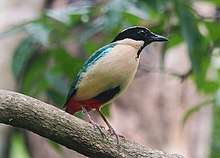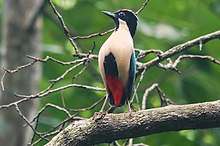Elegant pitta
The elegant pitta (Pitta elegans) is a species of passerine bird in the pitta family Pittidae. It is endemic to Indonesia, where it is found in the Lesser Sunda Islands and Moluccas.
| Elegant pitta | |
|---|---|
 | |
| Scientific classification | |
| Kingdom: | Animalia |
| Phylum: | Chordata |
| Class: | Aves |
| Order: | Passeriformes |
| Family: | Pittidae |
| Genus: | Pitta |
| Species: | P. elegans |
| Binomial name | |
| Pitta elegans Temminck, 1836 | |
Taxonomy and subspecies distribution
The elegant pitta was described and illustrated by the Dutch zoologist Coenraad Jacob Temminck in 1836 from a specimen collected on the island of Timor. Temminck coined the binomial name Pitta elegans.[2][3]
The elegant pitta has sometimes been treated as a subspecies of the Indian pitta (P. brachyura), noisy pitta (P. versicolor) or blue-winged pitta (P. moluccensis).[4]
Six subspecies are recognised:[5]
- P. e. virginalis Hartert, 1896 – the small islands of Tanahjampea, Kalaotoa, and Kalao (between Sulawesi and Flores)
- P. e. vigorsii Gould, 1838 – islands southwest of New Guinea
- P. e. hutzi Meise, 1942 – island of Nusa Penida (southeast of Bali)
- P. e. concinna Gould, 1857 – Lombok, Sumbawa, Flores, Adonara, Lomblen and Alor (Lesser Sunda Islands)
- P. e. maria Hartert, 1896 – island of Sumba (south Lesser Sundas)
- P. e. elegans Temminck, 1836 – islands between east Sulawesi and west New Guinea
The subspecies P. e. vigorsii is sometimes considered to be a full species, the white-chinned pitta. Three other subspecies have been described but are now lumped in the preceding subspecies.[4]
Distribution and habitat
It is endemic to the Lesser Sunda Islands and Moluccas in Indonesia. It is reported as also being found in East Timor by some authors,[1] but the species has only been recorded on the western half of the island, in spite of suitable habitat.[6] Its natural habitats are tropical dry forests and tropical moist lowland forests.[4]
The nominate race is found in Timor, Semau, and Kisar. P. e. maria is found on Sumba, and P. e. concinna is found on Flores, Lombok and nearby islands. P. e. virginalis is found on Tanahjampea, Kalao and Kalaotoa, to the south of Sulawesi, and P. e. vigorsii ranges across Banda, Kasiui, Kur, Tiur, Kai Islands, Damar, and Babar.[4]
Description

The elegant pitta is 19 cm (7.5 in) long and weighs 47–77 g (1.7–2.7 oz). It has a black head, throat, chin and neck with a buff crown stripe. The upperparts are dark green, as are most of the wings, which also have a bright turquoise patch on the lesser coverts. The rump is turquoise-blue and the tail is black with a green tip. The underparts are mostly warm buff, with the centre black with a red patch below. The sexes are similar.[4]
References
- BirdLife International (2012). "Pitta elegans". IUCN Red List of Threatened Species. 2012. Retrieved 26 November 2013.CS1 maint: ref=harv (link)
- Temminck, Coenraad Jacob (1836). Nouveau recueil de planches coloriées d'oiseaux, pour servir de suite et de complément aux planches enluminées de Buffon (in French). Volume 2. Paris: F.G. Levrault. Plate 591, Fig. 2 Folio 100. The 5 volumes were originally issued in 102 parts, 1820-1839
- Traylor, Melvin A. Jr, ed. (1979). Check-list of Birds of the World. Volume 8. Cambridge, Massachusetts: Museum of Comparative Zoology. p. 328.
- Eritzoe, J.; de Juana, E. (2018). del Hoyo, Josep; Elliott, Andrew; Sargatal, Jordi; Christie, David A.; de Juana, Eduardo (eds.). "Elegant Pitta (Pitta elegans)". Handbook of the Birds of the World Alive. Barcelona, Spain: Lynx Edicions. Retrieved 28 August 2018.
- Gill, Frank; Donsker, David, eds. (2019). "NZ wrens, broadbills & pittas". World Bird List Version 8.2. International Ornithologists' Union. Retrieved 16 January 2019.
- Trainor, C.R.; Santana, F.; Pinto, P.; Xavier, A.F.; Safford, R.; Grimmett, R. (2008). "Birds, birding and conservation in Timor-Leste". BirdingASIA. 9: 16–45.
